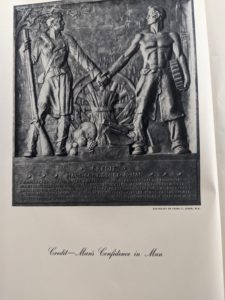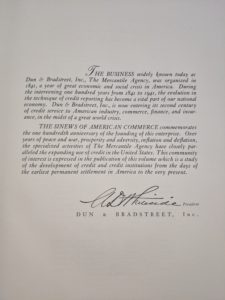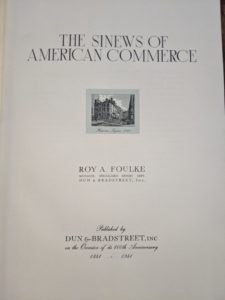#3: Roy A. Foulke, The Sinews of American Commerce (New York: Dun & Bradstreet, Inc., 1941). No price.
How did I get it:
The book was recently given to me as a housegift by someone who knows that my proclivities run in this direction.
Why:
The book is classic deaccessioning material. It is a commissioned history to celebrate the 100th anniversary of Dun & Bradstreet, a business information and credit research founded in 1841. Published in August 1941, just before the outbreak of direct US involvement in World War II, the book is a testament to a muscular, unapologetic capitalism that is hard to envision seeing in print today. The very title draws on the muscular metaphor, with the sinews of business credit agencies provides the linkages of the body commercial. Heavily bound and lavishly illustrated, the “library” staging of a steak house could not ask for a better volume on its shelves.
What:
The first two-thirds of the book is a history of credit in all its forms from the financing of the Jamestown Settlement and the Pilgrims up to the complicated arrangements of the Roosevelt Administration battling the Great Depression. For the entire colonial period and much of the early republic, there’s wasn’t enough specie (gold or silver) to go around, so credit in all its forms–including innumerable types of paper money, barter, pawnbroking, letters of credit, etc–was widely employed and quite sophisticated in its terms and calculations. The author uses a variety of primary and secondary sources to tell how business got done in this early period, and he bounces back and forth to compare with how credit is arranged in the author’s own time. The last third is the detailed history of Dun & Bradstreet, known for most of its history as The Mercantile Agency.
The Author:
Roy A. Foulke (1897-1994) was a forty-year employee of Dun & Bradstreet. He had retired in 1961 as a Vice President of the company.


